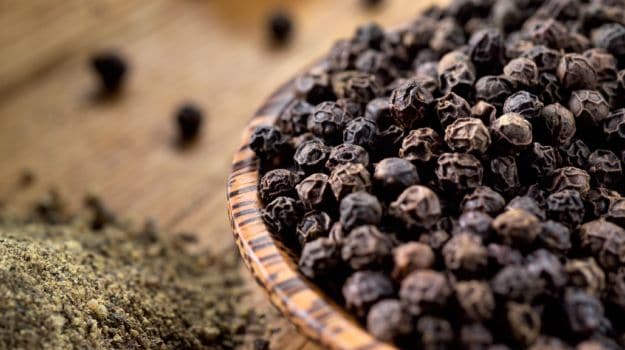Spices were one of the earliest trade commodities in India. Pepper was leading among the variety of spices cultivated in India. A native of India, pepper dates back to almost 2000 B.C. It was considered a very precious spice and was demanded, by the Goths from Rome, as ransom along with silk, gold and other gems. Pepper is also regarded as black gold due to its international trade factor.
Pepper requires a hot and humid climate and an average rainfall of 200mm. The western ghats in Kerala and Karnataka exhibit these conditions and are suitable for the growth of black pepper. Of the many regions that grow pepper, Malabar is the best suited. It was the first home to black pepper and to this day produces the finest black pepper. Let us go back in time to have a quick glimpse into the worldwide trade of pepper.
Spice trade between India and Egypt goes way back. Egyptians used peppercorns to fill the noses of the mummified bodies. The sea route that connected Malabar coast and Europe was one of the famous sea routes used to export pepper and other spices, Romans dominated this sea route to India. Later, Vasco de Gama set out to India in search of spices that led to the discovery of a new sea route. He exported almost two million kilograms of spices annually from India to Portugal. Portugal held an upper hand in the spice trade, following which Dutch took over. When Dutch colonies settled in Malabar, they traded pepper with south-eastern countries. They also took the plant to Vietnam, Java, Lampong and other distant lands. The fertile lands of Vietnam To this day, Vietnam remains the largest producer of pepper. When India was under British rule, they dominated the spice trade. India was the most sought out for spices owing to the fertile soil. Currently, in India, Karnataka, Kerala and Tamil Nadu are the leading pepper-producing states.
With pepper having travelled and settled world-wide, it has become a favourite condiment of many and is used in a variety of cuisines. Pepper livens up bland food, giving it a certain spice and warmth that tingles the taste buds. Many spice blends contain pepper in them because it enhances their flavour and provides a certain heat to the mix.

There are three types of peppercorns and each of them contribute to a different flavour. They are: green, black and, white. The berries that you see in the photograph above are termed as peppercorns and the crushed peppercorns that we see on our table is pepper. (In this article, to avoid confusion, the two will be used interchangeably with the same meaning as peppercorns.)
Green peppercorns are unripe berries that are harvested early and pickled in vinegar or brine. It is not allowed to dry. They have lesser concentration of spiciness and warmth in them than black pepper and hence are the least pungent among the three types.
Black peppercorns are picked only when the berries turn red. They are then immersed in boiling water for ten minutes, causing certain enzymes in them to turn the skin to dark brown or black in the next one hour or so. The berries are then allowed to dry for three to five days. They have a strong, spicy flavour. These are the peppercorns that we see on our dining table.
White peppercorns are fully-ripened berries that are soaked in water to soften the husk. The outer black husk is removed and dried. Their flavour is less intense than black peppercorns.
The pungency in pepper is due to the presence of an active compound known as Piperine which gives pepper the characteristic heat. Apart from piperine, it also contains other compounds such as lignans, alkaloids, and flavonoids. It also has certain aromatic compounds such as alpha-terpineol, acetophenones, citral, and many others that contribute to its aroma. Essential oils such as sabinene, pinene, linalool and limonene present in pepper also contribute to its musky and spicy aroma.
A teaspoon of pepper is a storehouse of folic acid, vitamin A, C, E and, K Niacin, Thiamin, and Riboflavin. Calcium, copper, iron, magnesium, and manganese are some of the main minerals in pepper.
Black pepper can be used on an assortment of dishes that include vegetables, fruits, soup, stew, meat and more, and is found in every household. After salt, it is the most frequently used spice. In India, pepper is used in many dishes such as Pongal and Khichdi; spice blends, especially in garam masala. Pepper rasam is a favourite among South Indians, especially during the monsoons or when there is a flu in the house. It also finds use in many traditional home remedies which are mentioned later in the article.

Pepper is a common ingredient used in other cuisines too. French prefer white pepper, especially in their cream sauces and spice mixes such as mignonette. White pepper is also preferred in Vietnamese, Chinese and Swedish cuisine. Middle Eastern cuisine also features pepper in their spice blends such as zhoug, Baharat, and berebere. Americans use pepper in salads, sauces, and soups too.
Pepper has a variety of uses apart from cooking. In most Indian households, Pepper is used to alleviate coughs and colds and is used to make kashayas / khadas (a concoction of herbs). The heat in the pepper is considered soothing to the throat and the sinuses. It is also used in the treatment of food poisoning, dysentery, and cholera. Pepper also has anti-carcinogenic properties revealed by the Ames test (which tests whether certain chemicals can cause mutations in DNA). Piperine inhibits some of the pro-inflammatory proteins secreted by tumour cells.
Piperine, along with enzymes present in the liver, has the ability to protect the liver from oxidative stress and damage. According to a study, pepper increases the bioavailability of curcumin, an active compound present in turmeric. A combination of pepper and turmeric has a more significant effect in terms of health benefits. Pepper has carminative properties. In other words, it causes a reflex flow of saliva and an increased secretion of gastric juice which improves appetite and also aids in digestion.
Pepper also helps to break down large fat molecules in the body and prevents accumulation of fat in the body. It also has antipyretic properties and can thus be used during a fever to bring down the body temperature. It can enhance body immunity by boosting the efficacy of white blood cells.

Pepper is mentioned in the Charaka Samhita and is termed as pipali. It increases internal heat and is thus used to strengthen Pitta dosha. Pitta dosha controls digestion, metabolism, and energy synthesis.
Pepper also decreases Vata and Kapha doshas. People belonging to the Vata type tend to have properties such as dryness, cold, and lightness in the body. To balance Vata, the person must opt for warmth in their life. Pepper can be a good addition to their diet to balance their doshas. Kapha dosha dominant people are physically heavy, and are usually overweight. Piperine in pepper stimulates the appetite and enhances metabolism aiding in weight loss.
Pepper is harvested when they are unripe and green in colour. According to practitioners, at this stage of development, pepper has rich healing properties. Some of it uses in Ayurvedic treatment are:
- pepper is used to treat respiratory diseases, as well as colic.
- Pepper oil is used to relieve a patient from pain (acts as an analgesic).Black pepper powder is
- used in many herbal tooth powder recipes.
- Gargling pepper decoction can alleviate tooth pain.
Certain home remedies as prescribed in Ayurveda are as follows:
- Pepper powder with honey and ghee to relieve cough.
- Pepper with jaggery and curd for a chronic cold.
If you are troubled by these chronic ailments, give these remedies a go. There is not a day when pepper is ignored in our daily life. Pepper finds its use in almost all walks of good health and with that, it is safe to say it is truly The King of all Spices.





